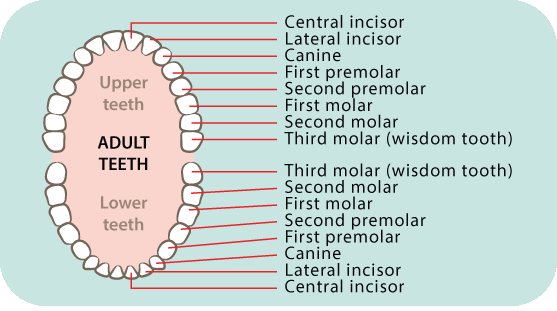How To Clean Teeth That Have Fallen Out
Teeth development
From 6-12 years, children have a mixture of adult and baby teeth. By the age of 12, most children have all their adult teeth except for their third molars (wisdom teeth). There are 32 adult teeth.
When adult teeth are coming through: some tips
Your child might find chewing is more difficult when their teeth are loose or missing, but your child still needs to eat healthy foods.
It's important to keep up your child's teeth-brushing routine, taking extra care around the loose teeth or sensitive areas. Butlet loose teeth fall out on their own. If you try to pull out a tooth before it's ready to fall out, it can injure the gums and nearby teeth. This can cause pain and infection.
Sometimes an adult tooth will come through before the baby tooth has fallen out. If the baby tooth hasn't fallen out within 2-3 months, see your dentist.


Dental care: keeping your child's teeth clean
Brushing teeth is important for keeping teeth clean, as well as for preventing bad breath, tooth decay and gum disease. At this age, your child probably doesn't need your help to clean their teeth anymore. But if your child needs a reminder, here are the basic steps:
- Use a pea-sized amount of regular adult fluoride toothpaste.
- Aim the toothbrush at a 45° angle to the gum line.
- Start with the top teeth first. Using a gentle circular motion, brush the outside surface of the teeth and gums, one tooth at a time. Then brush the inside surface of the teeth and gums, one tooth at a time.
- Move to the bottom teeth and repeat the above step.
- Use a light backwards and forwards motion to brush the chewing surfaces.
- Gently brush the tongue.
- Brush for around 2 minutes.
- Spit out the toothpaste as you clean. There's no need to rinse with water, though. Any leftover fluoride toothpaste helps to build strong, healthy teeth.
If you're using anelectric toothbrush, avoid moving the brush in circles. Keep your hand still, and guide the brush across the teeth and gums.
As well as brushing, your child should regularly floss any teeth that touch each other.
Choosing a toothbrush
There are so many toothbrushes to choose from that it can get pretty confusing. When you and your child are choosing a toothbrush, you can look for the following:
- Soft bristles: these won't damage your child's gums or tooth enamel.
- A long handle: this will help your child reach all their teeth.
- A small head: this will make it easy for your child to move the toothbrush around their mouth.
Electric toothbrushes are just as good as non-electric toothbrushes. They're particularly useful if your child has poor hand control.
No matter what toothbrush your child uses, it's a good idea to change it every 3-4 months or when the bristles start to look worn out and shaggy.
Toothpaste and fluoride
At this age, your child canuse regular adult fluoride toothpaste.
Fluoride is a safe mineral that keeps teeth strong and prevents tooth decay.
Mosttap water in Australia has added fluoride.
Fluoride works best when you get it in very small amounts throughout the day in fluoridated tap water, foods and drinks containing fluoride, and fluoride toothpaste. For children who are at high risk of developing tooth decay, dentists might also prescribe gels and pastes with extra fluoride.
Teeth cleaning alone isn't a guarantee against tooth decay. Diet is also important. Avoid giving your child sugary foods and sugary drinks like fruit juice, soft drink and flavoured milk.
Dental sealants
Your dentist might recommend dental sealants for your child.
Dental sealants are thin, plastic coatings that bond to the chewing surfaces of teeth, where most cavities in children are found. These sealants stop plaque build-up in the grooves of teeth and help stop tooth decay. Applying the sealants is usually simple and quick, with very little discomfort for your child.
Sealants don't stay on your child's teeth forever. Your dentist will check them regularly. They might sometimes need fixing or reapplying.
If you're interested in dental sealants for your child, speak to your dentist.
Visiting the dentist
It's important for your child to have regular dental check-ups. Your dentist will tell you how often your child needs a check-up. Dentists usually recommend every 6-12 months.
Your child might also see other oral health professionals, depending on your child's needs. These include dental therapists, dental hygienists, oral health therapists or specialist dentists like paediatric dentists or orthodontists.
Dental health care in Australia
Dental care for children is often free or low-cost in the public dental system, up to a certain age. For details of public dental providers, see your state or territory's health department website.
There are private dental clinics all over Australia. You'll have to pay for your appointments, but people with private health insurance might get some money back from their private health fund.
If you're eligible, the Australian Government's Child Dental Benefits Schedule covers basic dental services for children aged 2-17 years at most private and public dental clinics.
How To Clean Teeth That Have Fallen Out
Source: https://raisingchildren.net.au/pre-teens/healthy-lifestyle/hygiene-dental-care/dental-care-9-11-years
Posted by: ellisbelve1990.blogspot.com

0 Response to "How To Clean Teeth That Have Fallen Out"
Post a Comment